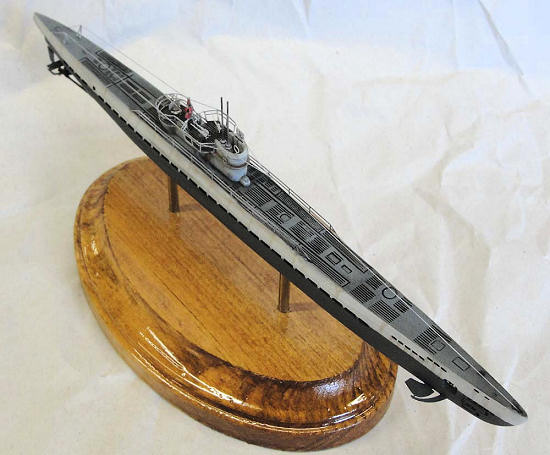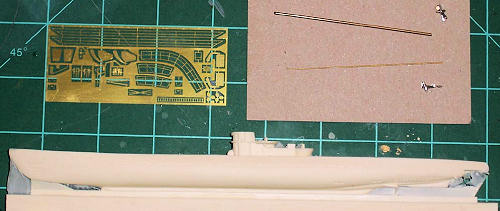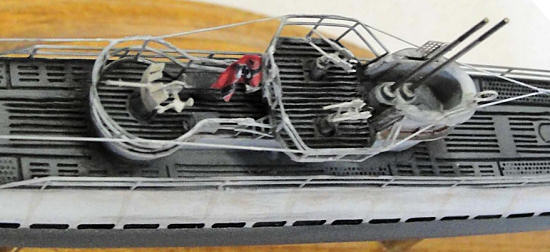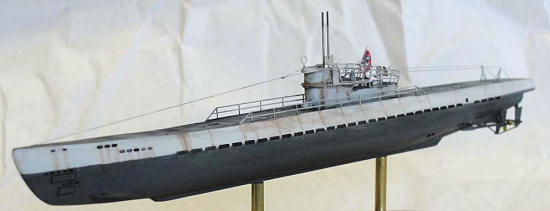
Yankee Modelworks 1/350 Late War
Type IXc U-Boat
| KIT #: | YKM-35028 |
| PRICE: |
$29.00
from www.earlshobbyhangar.com |
| DECALS: | None |
| REVIEWER: | Kyle Bodily |
| NOTES: | Resin with photo etch parts |

| HISTORY |
The Type IX U-boat was
developed in the years leading up to World War II when the German Navy
recognized it would need submarines with sufficient range to operate far beyond
the
The type IXc was an
improvement on the type IXb. It had
greater storage for additional 43 tons of fuel that gave it an increase in range
to 13400 nautical miles at 10 knots.
This type also had the control room periscope removed leaving it with two
periscopes like the Type
Some 35 Type IXc boats were built to
carry mines and could carry 44
 The
Type IXc U-boat U-507 was launched on July 15, 1941 at Deutsche Werft AG in
The
Type IXc U-boat U-507 was launched on July 15, 1941 at Deutsche Werft AG in
The U-507 had no luck on her
first combat patrol, but on
This very successful patrol
accounted for 48,462 tons of allied shipping sunk or damaged in the
On her third patrol the
U-507 was sent to operate off the cost of
The U-507 started her third
patrol with a bang by sinking six Brazilian ships in four days between 16 to 19
August 1942 sinking 14,911 tons causing some 607 casualties.
The U-507 would claim two more ships, bringing her third patrol total to
23,285 tons sunk. Because of the
heavy losses suffered by
On her way back to Loeient
she received a radio call for assistance from the U-156.
The U-156 had torpedoed and sank a large
 The
commander of U-156 also sent out in the clear an uncoded message that he was
conducting rescue operations and would not attack any vessel so long as he was
not attacked himself. The British intercepted the message and sent it the
Americans to which the Americans sent a B-24 Liberator from
The
commander of U-156 also sent out in the clear an uncoded message that he was
conducting rescue operations and would not attack any vessel so long as he was
not attacked himself. The British intercepted the message and sent it the
Americans to which the Americans sent a B-24 Liberator from
The German
commander-in-chief of U-boats or (Befehlshaber der Unterseeboote), Vizeadmiral
Karl Dönitz, subsequently issued what became known as the "Laconia Order," which
forbade U-boat captains from attempting to rescue or provide any assistance to
include food and water to survivors of ships they had torpedoed. Stating “if
they would murder their own men to sink a U-boat what else can we do”.
After the war, one of the
charges specifically mentioned at Dönitz’s trial for war crimes was “Laconia
Order”. Dönitz successfully
defended himself on this charge when he pointed out that U.S. submarines
operating in the Pacific followed exactly the same procedures.
This one patrol put the
U-507 in a firestorm along with being involved in the infamous Laconia incident,
her sinking of those Brazilian ships really had an enormous effect.
Not only did Brazil declare for the allies but Brazil sent the Brazilian
Expeditionary force to fight the Germans in Europe and sent a squadron of ships
to the Atlantic. But more ominously
it made Brazil open to the idea of having U.S. aircraft operate out of her
territory. This took away the
advantage that the U-boats had in the South Atlantic.
On her fourth patrol she
went right to work and sank three British ships off the North Brazilian coast.
On 9 January 1943 her Captain was notified that he had won the coveted
Knight's Cross. But their luck
would not hold out for long. On 13
January 1943 the U-507 was spotted by a
The U-507 accounted well for her self. During four war patrols, 227 days at sea, she sank nineteen ships for 77,143 tons and damaged another one for an additional 6,561 tons
| THE KIT |
This is my second model from
Yankee Modelworks and I have to say that it builds very much like the U-35 kit
that I built last year.
The kit comes in a very
sturdy box that I’ve already started to use to store stuff in.
This kit like the other, is a one-piece hull
 with the
conning tower as part of the hull.
I’m always very impressed by these kits.
Nice little joint lines and the deck has very deeply cut grooves that
give it the appearance that there is a pressure hull just underneath.
Every time I look at the kit it I am more and more impressed.
The rest of the kit includes a nice fret of photo-etch of some
twenty-eight parts including the water screws, deck and wintergarden rails.
Even a complement of Flak guns.
The other parts are the drive shaft supports and two diameters of brass
wire to make the driveshafts and the periscopes.
with the
conning tower as part of the hull.
I’m always very impressed by these kits.
Nice little joint lines and the deck has very deeply cut grooves that
give it the appearance that there is a pressure hull just underneath.
Every time I look at the kit it I am more and more impressed.
The rest of the kit includes a nice fret of photo-etch of some
twenty-eight parts including the water screws, deck and wintergarden rails.
Even a complement of Flak guns.
The other parts are the drive shaft supports and two diameters of brass
wire to make the driveshafts and the periscopes.
The instructions, yes I guess we’ll need them. They come complete with history and clearly show the proper placing of the parts. I’m sure that I will find a way to confuse thing but I think they will assist in reducing any self induced variable. The only thing that in my mind was missing was decals and flags. This really is no showstopper but would have been a nice touch.
| CONSTRUCTION |
My first step was to add two
brass rods to the hull to mount it on a stand and to also act as handholds.
I find this quite handy since you don’t have too many things to hold as
you build one of these boats.
I began to detail the boat
with the photo-etch and used cyanoacrylite/super glue to attach the parts.
I have found when I am gluing these railings that it is good to go slow.
I like to glue about a ¼ inch on curves or about a full inch on the s traight
parts. I must say that I sure like
the way they look when done. While
I was letting the glue set, I went to the local craft store and got a wood stand
for fifty cents.
traight
parts. I must say that I sure like
the way they look when done. While
I was letting the glue set, I went to the local craft store and got a wood stand
for fifty cents.
I like to put all the detail
parts on the model before I paint.
The only parts that I didn’t put on were the screws and the rigging.
After everything was done and the glue was dry the boat was ready to
paint. I looked very hard but to no
avail. I just couldn’t find any
photos of the U-507 so I decided to paint it in a standard finish using photos
of other boats operating in the Caribbean.
After everything was dry I
added the screws and a flag from the excellent sheet by Tauro.
I like stuff like that since it seems to really bring things to life for
me
I mounted the whole thing on
the stand and rigged with 2lbs fishing line.
The hardest part here was the “Y” in the front guide wire.
After that, the rest was easy.
There you have it. All you need is to add some imagination and CRACK!, flash of light, smoky smell and you’ll be done.
| COLORS & MARKINGS |
 The paint
scheme was an overall coat of Silver gray.
After it had dried I masked off the upper hull and painted all horizontal
surfaces a gray that I mixed from the silver gray and anthracite gray.
My goal here was to fade the colors to simulate the type of fading that
would be common in the Caribbean or at the equator.
After all was dry I painted the lower hull straight Anthracite gray.
I used the same technique to weather the kit as I do on most of my
builds. That is, I start out with a
very diluted color like rust- so diluted that only one coat is almost
undetectable, and I add coats to darken it as needed.
The paint
scheme was an overall coat of Silver gray.
After it had dried I masked off the upper hull and painted all horizontal
surfaces a gray that I mixed from the silver gray and anthracite gray.
My goal here was to fade the colors to simulate the type of fading that
would be common in the Caribbean or at the equator.
After all was dry I painted the lower hull straight Anthracite gray.
I used the same technique to weather the kit as I do on most of my
builds. That is, I start out with a
very diluted color like rust- so diluted that only one coat is almost
undetectable, and I add coats to darken it as needed.
| CONCLUSIONS |
Well that is about all there
was to it. All in all it was a very
enjoyable build. The kit is small,
only about seven inches or 17cm but it is well cast and somewhat simple.
I think it would be a good first all resin ship kit. It is relatively inexpensive and simple.
| REFERENCES |
“U-boats in action”
Squadron/Signal Warships #1
“U-boat War” Squadron/Signal
Books
“The U-boat net”
www.uboat.net
lots of information here.
http://www.uboatarchive.net/DesignStudiesTypeIXC.htm